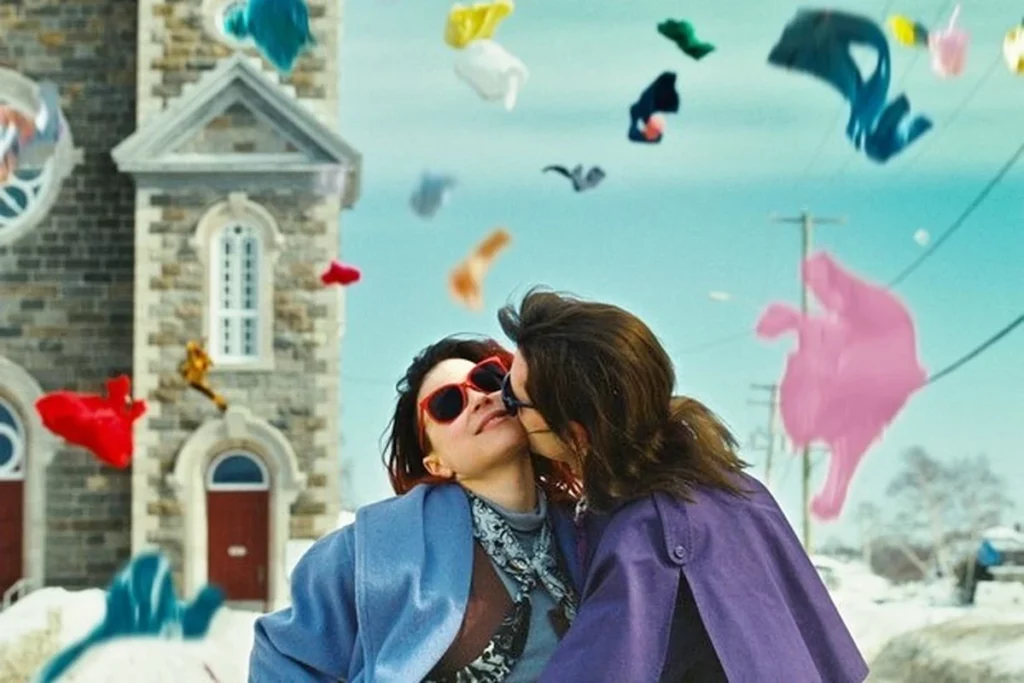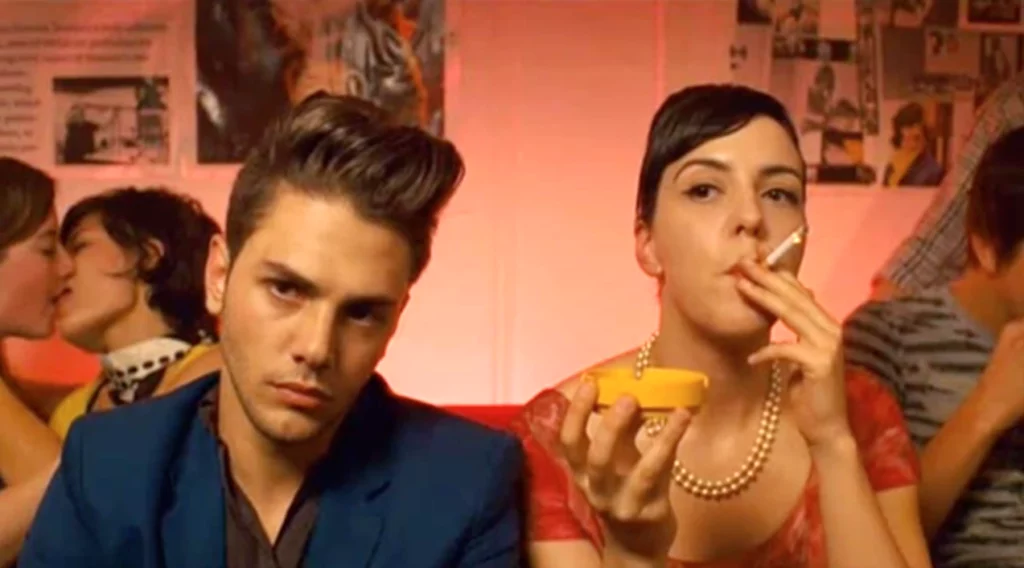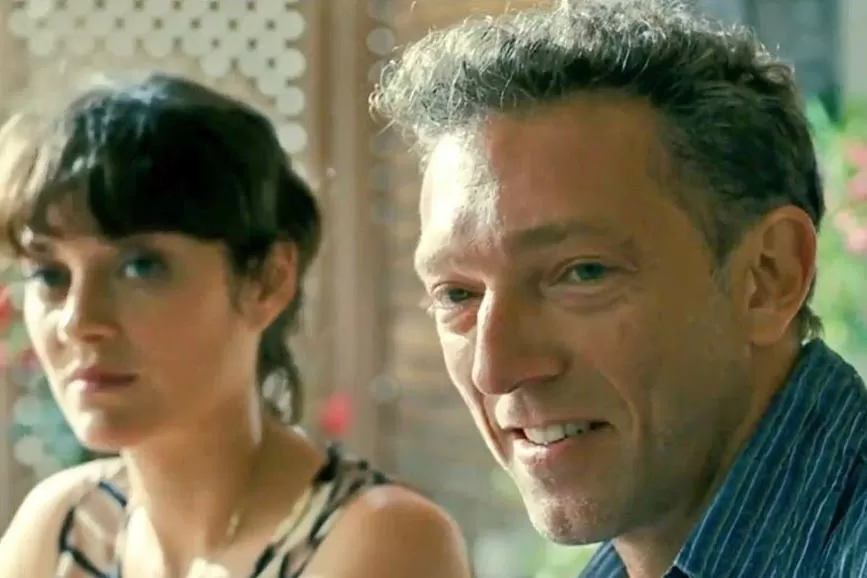7. The Death and Life of John F. Donovan (2018)
Image Via Les Films Séville
Dubbed by critics as the “worst” film in his career, Dolan’s English-language debut, The Death and Life of John F. Donovan, is perhaps a bit too harshly judged and underrated. It’s certainly a narratively ambitious film, concerning a young man named Rupert being interviewed by a journalist after writing a book about his childhood correspondence with the late actor John F. Donovan (Kit Harrington). Told mainly through flashbacks, we see Rupert growing up as a child interspersed with moments from Donovan’s troubled life.
The Death and Life of John F. Donovan is an emotionally wrenching story, bogged down by the fact that it resorts to melodrama and narrative clichés a bit too often. And as is the case with many-a-Dolan-film, there is a good deal of music choices that ran the gamut from being obnoxious to straight-up cringy (the film is bookended in its credit sequences with Adele’s “Rolling in the Deep” and “Bitter Sweet Symphony” by The Verve. Sigh.) Despite its flaws, the film is clearly a very personal story for Dolan, and the emotion that does manage to shine through saves it from being a complete disaster.
3) Laurence anyways
 Laurence Anyways (640×360)
Laurence Anyways (640×360)
Third feature film for Dolan who, through a narrative that covers a span of ten years, manages to return a profound reflection that undermines the laws of nature and bigoted religious postulates behind which lurk deep-rooted prejudices to be eradicated. Not a hymn to transgression, but a heartfelt parable on the free manifestation of one’s individuality. Thanks to Dolan’s sensitivity all differences are canceled, without neglecting the load of suffering that every choice in life entails. Ultimately, it is also a poignant contemporary love story that sweeps away the well-worn topoi of the genre. Extraordinary Melvil Poupaud, capable of rendering the innumerable facets of the protagonist without the slightest forcing. Impossible not to be moved at the end.
5. Tom at the Farm (2013)
Image Via MK2
Described as “Hitchcockian” upon its release, Tom at the Farm is Dolan’s crack at the suspense genre. Based upon a play by Michel Marc Bouchard, the film stars Dolan as the titular Tom, who travels to his late lover’s farm to deliver a eulogy for his funeral. A psychological cat and mouse game begins to ensue between Tom and his lover’s brother, Francis (Pierre-Yves Cardinal), once he decides to stay on at the farm. What results is a tense exploration of repressed sexual desire and masculinity.
The comparisons to Hitchcock are probably a bit random and don’t do justice to the unique way in which Dolan cinematically extracts suspense and tension. While it doesn’t quite outdo the staginess of its source material, Tom at the Farm sees Dolan drawing back, allowing subtlety to creep into the film’s characters and performances. The word “subtlety” and Xavier Dolan are normally never used in the same sentence, but this film is proof that when Dolan dials back, something magical happens.
What is the Suspension of Disbelief in Film and TV?
You need the audience to buy into your world when writing your screenplay and directing your movie.
Have you ever watched a movie or series and you don’t fully buy into the world? Maybe things get too unbelievable too fast, or you don’t feel like the rules established make sense or stay true to themselves.
If so, it’s likely the world building that’s pulling you away from the story. Taking you out of Westeros, or Narnia, or what have you, and inciting an issue with suspension of disbelief.
That’s why in this piece we’re going to go over that principle and show how it allows the audience to be completely immersed in the world. It’s the invisible thread that weaves through the fabric of storytelling, binding viewers to the narrative.
And if you don’t have it, you’ve lost your audience. Then what?
Let’s dive in and see what we can uncover.
Suspension of Disbelief Definition
‘Indiana Jones and the Kingdom of the Crystal Skull’Credit: Paramount Pictures
Suspension of disbelief is a fundamental concept in the world of film and television, essential for the enjoyment and engagement of audiences in storytelling.
The term refers to the willingness of an audience to overlook the wondrous and fantastical parts of a narrative, allowing themselves to be fully immersed in the story, regardless of how improbable the plot might be.
The Origin of Suspension of Disbelief
The term «suspension of disbelief» was first coined by Samuel Taylor Coleridge, the famous poet and philosopher, in the early 19th century.
«That willing suspension of disbelief for the moment, which constitutes poetic faith».
It speaks to the unspoken contract between storytellers and their audience, wherein viewers agree to accept the narrative presented to them.
What Is Its Role in Storytelling?
‘The Marvels’
Credit: Walt Disney Studios Motion Pictures
In film and TV, suspension of disbelief is crucial. It allows viewers to engage with stories that have elements of fantasy, science fiction, or supernatural occurrences without being constantly reminded of the implausibility of these elements.
It’s the bridge between «That could never happen» and «That could totally happen (in this movie or TV show).»
For example, audiences can enjoy superhero movies without questioning how a character can fly or have superhuman strength.
This willingness to suspend disbelief is what makes genre fair accessible.
Techniques to Foster Suspension of Disbelief
- Consistency in Worldbuilding: A narrative must establish its own set of rules and stick to them. Even if these rules differ from real-world logic, consistency makes the story’s world believable and immersive.
- Compelling Characters and Storylines: Strong character development and engaging storylines can divert the audience’s attention from fantastical elements in the narrative, focusing instead on the characters’ journeys and emotions.
- Cinematic Techniques: Skillful use of cinematography, sound design, and editing can enhance the realism of a film or TV show, even when the narrative delves into the wondrous.
The suspension of disbelief is a vital component of storytelling in film and TV. It allows audiences to escape into worlds of fantasy and imagination, forming an essential part of the magic of cinema and television.
As technology and storytelling techniques continue to evolve, so too will the ways in which filmmakers and storytellers engage audiences, asking them to suspend their disbelief in new and exciting ways.
Let us know if we’ve suspended your disbelief in the comments.
Keep ReadingShow less
Оно 2 (2019) (It: Chapter Two)
Драма, Зарубежный фильм, Ужасы, Фэнтези
tagHD 2160р, tagHD 1080, tagHD 720, tagЭкранизация
Экранизация по произведению: Стивен Кинг
Режиссер: Андрес Мускетти
В ролях: Джессика Честейн, Билл Скарсгард, Джеймс МакЭвой
Подросткам во главе с Майклом однажды удалось уничтожить кровожадного клоуна Пеннивайза, скрывающегося в канализационных проходах. Тогда от лап клоуна погиб брат Майкла, но он смог отомстить кровожадному существу. Вскоре подростки уехали из города. Сам же Майк остался жить в городе. Спустя долгое время город всколыхнула страшная весть о смерти ребёнка. Майк понял, что клоун вернулся, несмотря на то, что ему вместе с друзьями удалось убить его, по крайней мере, так им казалось. Однако все улики указывали на то, что это был именно Пеннивайз. Он решил созвать всех друзей, чтобы поделиться страшной вестью и снова вместе попытаться убить клоуна, но на этот раз окончательно.
2. I Killed My Mother (2010)
Image Via K Films Amerique
Dolan’s debut which he made at 20 years old, I Killed My Mother is an immature film by an immature filmmaker. And that’s exactly what makes it so powerful. Visually and narratively lacking polish along with being bombastically dramatic, Dolan’s passion as a young filmmaker telling a very personal story that he had just recently lived through is more than apparent. As a result, the film is an intimately cinematic juggernaut, filled with all the awkward quirks and raging emotions inherent in being a person approaching young adulthood.
The semi-autobiographical story follows Hubert (played by Dolan himself) as a young man struggling to live alongside his mother, Chantale (Anne Dorval, a perennial mother in most Dolan films). Their relationship becomes even more strained when Chantale discovers that Hubert is gay and has a boyfriend. Feeling almost like a modern-day adaptation of François Truffaut’s The 400 Blows, I Killed My Mother deserves a spot in the pantheon of essential coming-of-age films, made even more special for the fact that it was created by someone who had actually just come of age, already more than ready to tell their story.
6. Laurence Anyways (2012)
Image Via Alliance VivaFilm
An epic-length depiction of the life of a transgender woman named Laurence (Melvil Poupaud), Laurence Anyways is a film where Dolan’s penchant for camp and melodrama works, mainly because he takes it to such an extreme and unapologetic level that it becomes a part of the film’s identity. Seen in hallucinatory sequences such as when Laurence’s girlfriend Fred (Suzanne Clément) arrives at a party (on a conveyor belt) or when Laurence and Fred stroll through an empty street as a barrage of clothing articles rain down on them like confetti; the film uses colorful and glitzy expressionism to visually convey the film’s loud emotions.
And boy, are the film’s emotions piercing. Clément’s powerhouse performance (which she won an award for at Cannes) is particularly incredible in a scene where she vents all of her frustrations out and nearly loses her mind after a waitress makes a snide remark toward Laurence. What would normally be flaws in a Dolan film are turned into strengths in Laurence Anyways, although the film does drag on for a bit too long, nearly reaching the three-hour mark. Regardless, Laurence Anyways sees Dolan as a young 20-something already showing clear command of his craft and cinematic voice.
 My life with John F. Donovan
My life with John F. Donovan
 My Life with John F. Donovan (640×360)
My Life with John F. Donovan (640×360)
Let’s open the dances with the first film by Xavier Dolan made in the USA. Rupert Turner is eight years old and has a huge passion for John F. Donovan (played by the star of Game of Thrones, Kit Harington), star of American television and superhero on the big screen. An irreducible fan, she starts a regular correspondence with him that she hides from everyone, even from his mother, a young woman in distress who is trying to rebuild her life. However, the secret does not escape the school bully, who steals Rupert’s letters, unleashing his anger and the disproportionate reaction of the media. But Rupert is stronger than everything, even his idol, which he follows in the footsteps of becoming an equally successful actor. A star who confesses to the microphone of a skeptical journalist to whom she tells about her life with John F. Donovan. An intimate and fragile work about celebrity and the toxicity of fame.
6) Heartbeats
 Heartbeats (640×360)
Heartbeats (640×360)
We continue with the director’s second film in chronological order: Les amours imaginaires, anglicized in Heartbeats. Francis – always Xavier Dolan – and Marie are two boys from Montréal, who live a serene and fulfilling friendship under the banner of a common passion for fashion. Their relationship is disrupted by the arrival in the city of Nicolas, an attractive and bewitching country boy who soon becomes the object of desire for both. Francis and Marie want something more from Nicolas than friendship, and therefore they set up a kind of love challenge to gain the time and attention of the newcomer, who, for his part, never lets himself go completely.
Au Revoir les Enfants (1987)
https://www.youtube.com/watch?v=lKV9gCf6VvM
Dolan has always put Malle in the list of his favorite directors. He loves how the director is able to flirt with genres, trying all sorts of things while traveling around the world. Dolan notes that often, in the middle of the day, he would think of scenes from Au revoir les enfants. For instance, the restaurant sequence with the mother has been really inspiring for him. Describing Malle’s work Dolan spits a few adjectives like – Contrast, antagonism, emotions, brute emotions. The rest is craft and mastery. But emotions. That is what he aims for. That is what we get.
8. It’s Only the End of the World (2016)
Image Via Entertainment One
Winner of the Grand Prix at the 2016 Cannes Film Festival, It’s Only the End of the World plays out a bit like a TV movie. There’s no denying that the ensemble cast consists of all brilliant actors (Gaspard Ulliel, Nathalie Baye, Vincent Cassel, Marion Cotillard, and Léa Seydoux), but they aren’t necessarily given the best material to work with. Based on a play by Jean-Luc Lagarce, the film follows a playwright (Ulliel) who comes to visit his family with whom he has a strained relationship.
High on the melodrama and low on emotional impact, It’s the End of the World consists mainly of tense arguments between characters that culminate in shouting and a lack of resolution. The characters themselves aren’t particularly interesting, and for the most part, the film doesn’t quite outgrow the staginess of its source, often feeling like a filmed stage play. On top of that, the film contains what is perhaps the most jarringly bad needle drop in any Dolan film…perhaps any film ever. If you’ve seen the film, you’ll know exactly what one I’m talking about.
4. Heartbeats (2010)
Image Via Remstar Distribution
Dolan’s second feature, Heartbeats, is a headily sensual story of desire and unrequited longing. The film stars Dolan as Francis, who, along with his best friend Marie (Monia Chokri), vies for the affection of Nicolas (Niels Schneider), their object of infatuation. Undoubtedly taking influence from the king of sensual cinema Wong Kar-wai, Heartbeats goes all-in with its style, utilizing slow-motion and vibrant neon lighting to illustrate the feelings of its protagonists. The result is a visually captivating film that humorously but effectively captures the emotions of being a young and horny 20-something.
The film isn’t without its narrative kinks, however. Scattered throughout the film are talking-head segments of young men and women being interviewed about their love lives. These scenes don’t really amount to much other than the run time of the film and could have easily been cut out with nothing lost. That being said, Dolan’s youthful exuberance as a new and young voice in arthouse cinema is nothing short of infectious; flaws and all, Heartbeats is a highlight in Dolan’s career.
1. Mommy (2014)
Image Via Les Films Séville
Mommy, without a doubt, is Xavier Dolan’s magnum opus. A strikingly intimate character-driven drama featuring powerhouse performances from its three lead actors (Anne Dorval, Antoine Olivier Pilon, and Suzanne Clément), the film takes a nosedive into explosive emotional territory. The film’s emotional extremes never end up feeling like campy melodrama, however, because of how compelling and multidimensional the characters are. Dorval plays a mother struggling to take care of her behaviorally unsound teenage son (Pilon). After striking up a friendship with their next-door neighbor (Clément), the three of them become almost like a family unit, taking care of each other through the dire circumstances they find themselves in.
7) It’s just the end of the world
 It’s Only the End of the World (640×360)
It’s Only the End of the World (640×360)
In seventh position we find the sixth film by Xavier Dolan, awarded at Cannes with the Grand Prix in 2016. It’s only the end of the world – based on the pièce Juste la fin du monde by Jean-Luc Lagarce – does not deviate from the theatrical text but reworks in a typically Dolanian architecture of claustrophobic images, glued to the faces of the characters, portrayed in close-ups that overflow from the screen. The word of the original text, fragmented and complex, is not simply transformed into verbal language but takes on a sound value – with loud, redundant, obsessive dialogues – and a visual value – through the exclusive use of the face in long sequences of shots and reverse shots.
3. Matthias & Maxime (2019)
Image Via Les Films Séville
Dolan’s newest feature film, Matthias & Maxime, plays out almost like a greatest-hits album, in the sense that its narrative is chock full of tried-and-true Dolan thematic elements from films past: unrequited love, gay desire, mommy issues, all set to a barrage of cheesy needle drops. It doesn’t necessarily capture any single element perfectly, but it does highlight Dolan’s evolution as a filmmaker, providing a bittersweet portrait of a young man entering full-fledged adulthood. Dolan turned 30 the year this film came out, and it’s not difficult to see that this is a very personal story for him to tell.
The film stars Dolan as Max, a young man who develops romantic feelings for Matt (Gabriel D’Almeida Freitas), his best friend since childhood. This central love story is set against other narrative threads, such as Max’s complicated relationship with his mother (Anne Dorval) and tensions within Matt and Max’s friend group. While the emotional impact of the film is somewhat blunted by its juggling of these different threads, Matthias & Maxime manages to endearingly and creatively reveal different facets of the same Dolan tropes, even if they were done better in other films.
Xavier Dolan’s six definitive films:
I Killed My Mother (2009)
Dolan’s directorial debut feature was also his major breakthrough which only happens when there’s great talent at play. A semi-autobiographical coming-of-age film made by a 19-year-old Dolan who wrote it, produced it and starred in it, I Killed My Mother is the perfect entry into Dolan’s work.
It chronicles the intense love-hate relationship between a 16-year-old gay boy and his mother. Laden with extensive psychological subtext, I Killed My Mother is so effective because its origins are extremely personal. The film ended up receiving a standing ovation at Cannes and got multiple accolades at the Director’s Fortnight program.
https://youtube.com/watch?v=p3vc7H_bSFU
Heartbeats (2010)
Dolan’s follow-up to I Killed My Mother reinforced his status as a filmmaker of promise. A stylised romantic drama, Heartbeats follows the extremely turbulent emotional journeys of two best friends who somehow end up falling in love with the same man.
Influenced by movements such as the French New Wave as well as other modern pioneers like Wong Kar-wai, the aesthetic frameworks of Heartbeats borrows from many sources of inspiration but it manages to successfully construct a coherent cinematic vision.
Laurence Anyways (2012)
Probably the crowning jewel of Dolan’s directorial career, Laurence Anyways is the perfect example of the beauty of New Queer Cinema. The film follows the life of Laurence – an acclaimed novelist who comes out to her girlfriend as a trans woman.
Although she does not take it well at first, she eventually becomes an indispensable part of Laurence’s journey. Despite all the societal prejudices and the omnipresent transphobia, Laurence moves forward with her life while her girlfriend drifts away.
Tom at the Farm (2013)
An adaptation of a play by Michel Marc Bouchard, Tom at the Farm revolves around the titular character – a young editor from Montreal who decides to visit his boyfriend Guillaume’s rural community when he tragically passes away at the extremely young age of 25.
However, he soon realises that his lover’s mother has no idea about her dead son’s sexuality. Although his brother knows, he intimidates Tom into keeping quiet but things get complicated as more truths about Guillaume’s life come to the light.
Mommy (2014)
Another fantastic film by Dolan, Mommy features yet another collaboration between Dolan and Anne Dorval who plays the role of a widowed mother with a son who suffers from ADHD-related issues and has been diagnosed with an attachment disorder.
Dealing with financial problems and instances of domestic violence, the mother and son duo lead a volatile life until their strange new neighbour comes to their assistance. Mommy ended up winning the coveted Jury Prize at the Cannes Film Festival.
Matthias & Maxime (2019)
The latest directorial feature by Dolan, Matthias & Maxime is proof that Dolan has retained his top form after a few missteps. It tells the story of two men who have been friends all their lives but an interesting development takes place when they are asked to kiss for a student film.
The kiss plants doubts within their minds and forces them to rethink their relationship from a different perspective. One of the best Canadian films of the year, Matthias & Maxime provides enough evidence to come to the conclusion that Dolan has much more in store for the future.
2) I killed my mother
 I killed my mother (640×360)
I killed my mother (640×360)
The first film that saw the North American enfant prodige holding a film camera stops just a few centimeters from the first position. This is the directorial debut for Xavier Dolan, which highlights the clear talent of the Canadian behind the camera, at just 20 years old. The film was written when he was only 16, based on an autobiographical path. It tells the story of Hubert, a Canadian teenager who never had a father figure. The man, divorced from his wife, never really cared about his son’s life. He finds himself living with the impulses of his age, without a male role model. He keeps her homosexuality a secret from her mother, blaming her at the same time, accusing her of not loving him enough.
Forbidden Games (1952)
Xavier Dolan calls Forbidden Games as one of his top three love stories of all times. Punctuated by Narciso Yepes’s legendary score, the film gives this juvenile romance its fame and contributes to its magic. Dolan says that the movie is an entity of perfection. The artistic direction is meticulous and inspired; there’s a vanguard oneiric look to the film. Brigitte Fossey delivers an endearing and incredibly mature performance and looks the epitome of femininity despite her—gulp—six years of age. Xavier Dolan thinks that Forbidden Games is one of the greatest films of all time with a genuine and sensible study of youthful mores. He think that it creatively represents children’s universe. He funnily mentions that the film makes me want to be a pretentious critic.
1) Mommy
 Mommy (640×360)
Mommy (640×360)
There could only be Mommy in the first position of our ranking. A suffered and profound portrait of human fragility, of our being often full of contradictory emotions; contradictions that exist in the relationships we weave every day and in what we have been carrying on since the day we came into the world. The film tells the story of a young mother, a widow, particularly full of life, who finds herself having to manage her son full-time. She gets custody of him and she has no idea how to deal with all the emotional load that she brings. It is in fact a problematic 15-year-old, suffering from attention deficit. A duo lacking something to find their own balance and, amid a thousand discussions and attempts to make ends meet, here comes Kyla, the new and extravagant girl in the neighborhood, into their lives.
5) Tom at the farm
 Tom at the Farm (640×360)
Tom at the Farm (640×360)
Xavier Dolan has spent virtually his entire filmography exploring the concepts of identity, sexual orientation and how these affect a person’s relationship with the world in which they exist and move. Of all, his fourth film – Tom à la ferme – released in 2013, is perhaps the most emblematic of his poetics and, although it is less known than other titles such as, for example, Laurence Anyways or Mommy, it is a cinematic experience you really shouldn’t miss it. Xavier Dolan stages a story full of pain and unresolved feelings. His Tom Podowski travels to a remote country town, to the birthplace of his former boyfriend Guillaume, now dead. His family is hosting him for the funeral and it doesn’t take long to understand that Tom is not welcome there at all. From there, it all starts.






























